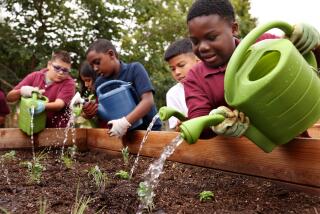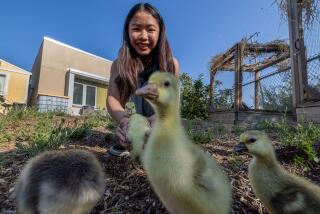Virtual Visits to Mars
Teaching classroom science has come a long way since the Sputnik days when children were challenged to construct satellites with hand-painted Styrofoam balls, coat hanger wire and glue.
Students today work in partnerships with NASA and the Jet Propulsion Laboratory, the National Science Foundation and university institutes to become versatile in the latest technology.
In one of the most ambitious science projects undertaken by the Los Angeles Unified School District, students at 22 Los Angeles middle schools are using model rovers equipped with cameras to explore large replicas of the Martian landscape.
Through computers and the Internet they collect digital camera images beamed from rovers that are prowling another school’s Martian landscape and assemble them into panoramas of the red planet’s tortured terrain.
Soon, a chosen few of those students will be selected by the Planetary Society to participate in a unique program that will give them control of a real National Aeronautics and Space Administration rover after it lands on Mars in 2001.
Computers, robotics and the Internet have created new horizons for science teachers. Students are building robots capable of sensing and measuring temperature and light. They are delving into forensic techniques and using holograms to study the behavior of light. They are creating habitats to gauge the effects of toxic pollutants on animals and insects and sending that information on to government agencies over the Internet.
As for space science, the Los Angeles district’s invasion of Mars is just the beginning, according to John Callas, research scientist with Jet Propulsion Laboratory’s Mars exploration program.
“The advancement of technology, computers and networking has allowed students to be as intimate with the discovery process as the scientists and engineers directly involved,” Callas said.
No longer restricting its science to experts, NASA is including public education components in its ongoing program to explore Mars with rovers and landers. The space agency will have a virtual telepresence on Mars, which allows for increased interaction with students.
“No one loses,” Callas said. “We receive fresh new ideas from students and the public even as our program enriches the educational experience.”
Judging from the expressions on students’ faces--and the unique machines they have constructed to peer and poke at the planet’s surface--nothing in the solar system is more fascinating than Mars, which this week is making its closest approach to Earth in nine years.
This week, the distance between Earth and Mars reached 54 million miles. The planets will not be this close to each other again until 2003.
South Gate Middle School eighth-grader Marielischia Eaton extolled the school’s Mars rover project for “teaching me a lot about the red planet and about working as a team in a little room with a lot of students--not an easy thing to do.”
“At first, I didn’t believe we were smart enough to do this project--and we fought over little things like rover design,” she said, “But our teacher, Tom Castle, said we were smart enough. He was right. Now, I have faith in our rover’s abilities because I have faith in our class.”
*
At the Foshay Learning Center in Los Angeles, Marvin Espino is among dozens of students so dedicated to the project that their teachers let them tinker with it after school, on weekends, even during vacation.
Marvin’s mother said his obsession had helped take his mind off a two-year battle with cancer. “He seems happier, more positive when he is working on the Mars project,” she said.
Surveying the 8-foot-square Martian landscape he helped design, Marvin, 14, blurted out, “I want to be an astronaut. I want to be the first man on Mars.”
“Mars once looked a lot like our own planet,” he said. “It had rivers and minerals like ours. It might have had life on it.
“So I’m going to direct the rover we built to first study rocks--figure out how big they are, how far away they are, what they’re made of.”
The district’s rover project, which was largely funded by the National Science Foundation and has taken about four months to complete, is immense.
It involves 22 Martian landscapes built out of plywood, paper, sand, chicken wire and red primer spray paint. Each landscape has a Lego-Dacta model rover crammed with motors, wires and cameras. About 800 students have trained in complex image processing techniques and 56 teachers have completed 30 hours of related professional development.
Each of the model rovers was “launched” to a replica of Mars at another participating school whose identity remains a secret to the builders. Using the Internet, students have been communicating with their rovers and downloading their black-and-white images.
The project will end with the students visiting the Mars base they have studied, remotely submitting 500-word papers outlining their results, and making presentations before their peers at a ceremony in June.
The program, which will soon be exported to schools in Idaho, Hawaii and New York, was developed by Joe Oliver, a Los Angeles school district mathematics and science/technology advisor, and Steven Dworetzky, a technology teacher at Thomas Starr King Middle School.
Standing beside a King classroom wall covered with topographical maps and color photographs of the surface of Mars, Oliver said, “I deliberately designed this program to take advantage of the size of [the school district], which, at 700 square miles, is bigger than three states. It involves a large number of schools many miles apart using the Internet to communicate.”
Never mind that a “divine intervention clause” allows students to pop wheels back on the rovers if they fall off.
“We’re improving the program all the time,” said Dworetzky. “One of my classes is already devising a mechanical arm to collect rock samples. We are also trying to devise a way of conducting chemical tests on rocks.”
“Those would be major achievement,” he said. “But then, it was once a major task just to get our rovers to turn right and left on simulated Martian landscapes.”
*
The middle school project is only one of several space projects underway. Dworetzky also is leading a group of high school students chosen to test-drive a real $150-million rover that NASA and JPL will soon be sending to Mars.
From a Hollywood classroom, three high school students used the Internet and satellite transmissions to maneuver that rover through an ancient lake bed in the Mojave Desert.
Participants included students and teachers from four cities across the country--Los Angeles, Phoenix, St. Louis and Ithaca, N.Y.--who used remote telemetry systems to conduct complex surface operations with the 150-pound rover.
It was quite a workout for the machine--and the students.
With Dworetzky hovering nearby, they sent commands to the rover, then watched it respond in real time on a screen in his classroom, which was packed with middle school students.
At one point, Dworetzky explained nervously that “we want it to investigate an area for fossilization. But we’ve got a problem. The rover’s hazard avoidance system is mistaking the people around it for rocks and trying to avoid them.”
A few minutes--and several course corrections--later, the rover was back on track.
“This is the kind of stuff that gets kids jazzed on science,” Oliver said. “This rover is real. It’s exciting. It’s relevant, and it’s soon to be in outer space.”
More to Read
Sign up for Essential California
The most important California stories and recommendations in your inbox every morning.
You may occasionally receive promotional content from the Los Angeles Times.











